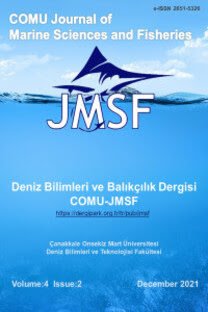Hindistan'ın Deniz Süs Kabuklarının Bir Kontrol Listesi: Dwarka ve Bet-Dwarka, Gujarat'dan Bir Vaka Çalışması
Koruma, Gelgit, Çeşitlilik, Kabuk el işi endüstrisi, Yararlanma
A Checklist of Marine Ornamental Molluscs of India: A Case Study from Dwarka and Bet-Dwarka, Gujarat
Conservation, Intertidal, Diversity, Shell Craft Industries, Exploitation,
___
- Alagerswami, K. & Maiyappan, M., M. (1987). Prospects and Problems of Management and Development of The Marine Molluscan Resources (Other than Cephalopods) in India. Central Marine Fisheries Research Institute, 44(1), 250-261.
- Appukuttan, K., K. (1979). Trochus and Turbo Fishery in Andamans. Seafood Export Journal, 11(1), 41-44.
- Appukuttan, K., K. (1996). Marine Molluscs and Their Conservation. Marine Biodiversity Conservation and Management.
- Appukuttan, K., K. (2008). Molluscan Resources and Management Strategies. National Seminar on Environmental Management for Sustainable Livelihood, 6-12.
- Appukuttan, K., K., & Ramadoss, K. (2000) Edible and Ornamental Gastropod Resource. Marine Fisheries Research and Management, 525-535. Apte, D. (2012). Field Guide to The Marine Life of India. First addition.
- Apte, P., M. (2012). The Building of Gandhinagar: New Capital of Gujarat, India.
- Arjunan, Babu., Venkatesan, V., & Rajagopal, S. (2011). Contribution to the knowledge of ornamental molluscs of Parangipettai, Southeast Coast of India. Advances in Applied Science Research, 2(5), 290-296.
- Durvey, V., S. (1975) .Commercial Marine Mollusc of India and The Need for Their Survey. Record of the Zoologycal Survey of India, (68) 421-429.
- http://faunaofindia.nic.in/PDFVolumes/records/068/01-04/0421-0429.pdf eol.org/pages/46462476
- Gaur, A., S. (2004). A unique Late Bronze Age copper fish-hook from Bet Dwarka Island, Gujarat, west coast of India: Evidence on the advanced fishing technology in ancient India. Current Science, 86 (4), 512-514.
- Gopalkrishnan, P. (1970). Some Observations of The Shore Ecology of The Okha Coast. Journal of Marine Biologycal Association of India, 12 (1&2), 15-34.
- Hornell, J.(1914) . The Sacret Chank of India: A Monograph of The Indian Conch (Turbinella pyrum ). Madras Fisheries’ Bureau (7).
- Kamboj, R., D., Joshi, D., M., & Parmar, H. (2019). Common Marine Mollusc of Gujarat. Gujarat Ecological Education and Research Foundation.
- Kapadia, K. (2018). Pilgrim tourism proposals in Dwarka, Gujrat, India. International research journal of Engineering and Technology (IRJET), 5(10), 889-892.
- Mohamed, K., S. (2012). Marine Molluscan Diversity in India –Exploitation and Conservation Challengesin The 21th Century. Marine Biodiversity Status, opportunities and Challenges, pp. 37-64, 2012.
- Mohamed, K.S, & Venkatesan, V. (2017) Marine Molluscan Diversity in India- Exploitation, Conservation. Summer School on Advance Methods for Fish Stock Assessment and Fisheries Management, 56-81.
- Narasimham, K., Kripa, V, & Balan, K .(1993). Molluscan Shellfish Resource of India- An overview. Indian Journal of Fisheries, 40 (1 & 2), 112-114.
- Natarajan, P., Ramadoss, K., Sivalingam, D., & Thillairajan, P. (1987) Ornamental Shell Industry of Ramanathpuram Coast. Central Marine Fisheries Research Institute, 42(1), 106-110.
- Patel, M., & Patel, H. (2019). Shell’s Field Guide. A Seashell Conchology a Samll Introduction of sea world. (E-book)
- Pillai K., M. & Devadoss, P. (1947). On the occurance of the sacred chank, Xancus pyrum of Porto Novo. Indian Jouranal of Fisheries, 21(1), 279-281.
- Pota K., A. & Patel, M., I. (1988). Exploitation and Marketing of Chanks from The Gulf of Kutch. Central Marine Fisheries Research Institute, 42(2), 445-450.
- Ramadoss, K. (2003). Gastropods, In: Status of Exploited Marine Fishery Resources of India. CMFRI, Cochin, 203-210.
- Ravinesh, R., Kumar, B., & Samuel, V., D. (2019) .Status of Marine Mollusc in illegal wildlife trade in India. TRAFFIC Post-December 2018, 2019.
- Sarvaiya, R., T. (1977). Studies on Mollusca of Saurashtra Coast-3 Composition. Fisheries Technology, 14 (2).
- Shyam, S. S., Jagadis, I., Venkatesan, V., Rahman, M., R., & Nashad, M. (2017a). “Gastropod landing, utilization and trade in India: A case study from Kollam, India,” The Marine Biological Association of India, 59(1).
- Shyam, S., S., Jagadis, I., Venkatesan, V., Kavitha, M., & Mohamed, K., S. (2017b). Ornamental gastropod shell trade in India: A macroeconomic assessment. Marine Fisheries Information Service Technical and Extension Series, 231.
- Soni H., B., & Thakur, K. (2015). Preliminary Checklist of Marine Mollusks from Beyt Dwarka, Gulf of Kutch(Eco-Sensitive Zone), Gujrat, India. International Journal of Environment ,4 (2) .
- Subba Rao, N., V. (2003). Indian seashell (part-1) Polyplacophora and Gastropoda. Records of The Zoological Survey of India, 20-34.
- WPA (2021). The Wild Life (Protection) Amendment Bill, 2021.
- WWF (2013). Commercially Important Gastropod Shell Resource and Trade in India: Distribution, Status and Conservation Strategies,” WWF Final Report, 2013. Vanhaeren, M., & Perle`s, C. (2010) .Black Cyclope neritea Marine Shell Ornaments in the Upper Palaeolithic and Mesolithic of Franchthi Cave, Greece: Arguments for Intentional Heat Treatment. Journal of Field Archaeology, 35(3), 298-310.
- Venkatesan, V. (2010). Marine Ornamental Molluscs. National Training Programme on Marine Ornamental Fish Culture-2010 at Mandapam CMFRI.
- Yayın Aralığı: 2
- Başlangıç: 2018
- Yayıncı: Çanakkale Onsekiz Mart Üniversitesi Deniz Bilimleri ve Teknolojisi Fakültesi
Samuel AMPONSAH, Berchie ASİEDU, Nii Commey AMARQUAYE, Emmanuel OFORİ-BOATENG, Nana Ama AFRANEWAA, Samuel HENNEH
Foça'da (Doğu Akdeniz, Türkiye) Trol Balıkçılığı Çöküşün Eşiğinde mi?
Mayurdan GADHAVİ, Zahra MAKDA, Dudhagara DARSHİTA, Shiyani JENİSHA, Shabanam SAİYAD
İzmir Körfezi (Ege Denizi) Lesepsiyen Balıkları
Irak'ta Balıkçılık Sektörünün Günümüzdeki Durumu: Eleştirel Bir Derleme
Muzaffer HARLIOĞLU, Shokri OMAR MUSTAFA MUSTAFA, Zahra BATOOL
Dondurarak Depolanan Balık Kıymasının Stabilizasyonu
